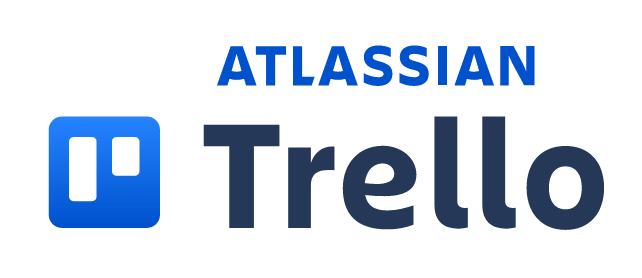Key Takeaways: What Is Scrum & How It Works
- The flexible and adaptive nature of Scrum is ideal for software development teams, but it can be used by teams in many industries.
- Agile Scrum teams are small and have three defined roles: scrum master, product owner and development team.
- Scrum is an Agile methodology that was built around the values and principles found in the Agile Manifesto.
Since the early ’90s, teams have been using Scrum to help them complete complex projects. Despite its popularity, many still don’t know what Scrum is. Nor do they understand how it can help them create high-quality deliverables, become better communicators and increase their efficiency. Here, we’ll answer the question “what is Scrum” and show you how to get started.
In this guide to Scrum and its Agile framework, you’ll learn all there is to know about this flexible methodology. By the end of it, you should know if it’s right for you and your team. Without further ado, let’s jump into it.
What Is Scrum Methodology?
Scrum was created for software developers who were tired of traditional project management methods. The Scrum method embraces the values and principles of the Agile Manifesto. It then builds upon them with a framework that encourages communication, collaboration and listening to clients, stakeholders and everyone on the team.
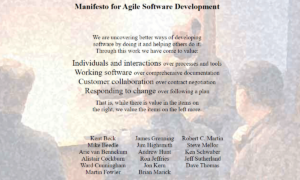
who were using rigid project management techniques.
In simple terms, Scrum is an Agile project management methodology for complex projects that small cross-functional teams use to work toward an end goal. It has tools and processes that help teams deliver high-quality products quickly and efficiently. Its methods are flexible, allow teams to self-manage and welcome client and stakeholder feedback throughout the development process.
Below, we will teach you what Scrum is, what Scrum’s values and principles are, the roles within a Scrum team, how Scrum works and what you need to do to get started with the method.
Scrum Values & Principles
For any project management methodology to work, it has to be built upon a foundation of values and principles. Scrum is based on the values and principles found in the Agile Manifesto, but it also has its own values and principles that teams must follow to be successful. In the following sections, we will look at Scrum-specific values and principles.
Scrum Values
To succeed and see measurable change, Scrum teams must embrace the methodology’s five core principles: courage, focus, openness, commitment and respect. We’ll quickly cover the five Scrum values below.
Courage
Scrum teams operate as one and not as individuals. The team rises, falls and makes challenging decisions together. As one cohesive unit, the team always does the right thing, regardless of how challenging it may be.
Focus
Teams remain focused on the task at hand. At no time do they take their eyes off the ball. Daily Scrum meetings and retrospective meetings help keep the team focused and ready.
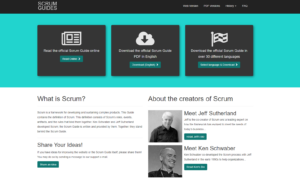
and Ken Scwaber, the founders of Scrum.
Openness
Every team member is open to feedback, learning and new ideas and has no problems sharing feelings about the project and where it is headed. Open communication builds trust, and when trust is built, work improves.
Commitment
Since Scrum teams are small, all members must be committed to the project they have been assigned to, their time-based tasks and each other.
Respect
Respect plays a key role in Scrum teams. Each team member respects everyone’s strengths and weaknesses, and no team member is left out to dry when problems arise. As mentioned in the courage section, Scrum teams operate as one, and respect is always mutual.
Scrum Principles
Like many project management methodologies, Scrum has a core set of principles that help guide teams through the Scrum process. The following sections will cover the three empirical principles that help make Scrum successful.
Transparency
Everyone involved in the Scrum process, from the clients to development team members, must be transparent, open and honest. Everything about the project must be out in the open so that the Scrum team can solve problems, share successes and adapt to customer demands and changing markets.

inspect themselves and their Scrum processes during retrospectives.
Inspection
Inspections within Scrum are not audits by a third party; they are internal reviews of the product being developed and the processes used by the team. Inspections require every team member to be transparent and honest to ensure continuous improvement.
Adaptation
The entire team must be able to adapt to meet customer requests, new processes that were discussed during inspections and other challenges. Adaptability can lead to better efficiency, reduced costs and shorter product delivery times.
How Does Scrum Work?
There are a lot of moving parts in the Scrum framework. Below, we will cover everything from Scrum roles and job functions to Scrum artifacts (tools) and Scrum events (meetings) so that you can better understand how things work in the world of Scrum.
Scrum Roles
Scrum teams are small, usually no more than 10 members. The whole point of Agile teams is to be flexible and adaptable so that large amounts of work can be completed in short time periods (sprints). This is simply not possible with large teams.
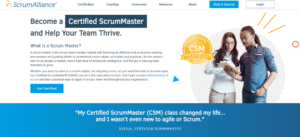
you have plenty of training options.
A Scrum team consists of three parts: the product owner, the scrum master and the development team. Below, we’ll break down each so that you can learn about Scrum team members and their roles.
Product Owner
The product owner is a messenger between the development team, clients and stakeholders. They aim to deliver the best value possible to all involved. Responsibilities include populating the backlog with user stories, guiding the development team and deciding when to deliver the product.
Scrum Master
The scrum master is the leader of the Scrum team. Their job is to coach teams on Scrum best practices and understand the work being performed. The scrum master must be an excellent communicator, an effective collaborator and an expert problem solver. The scrum master is responsible for all resources and Scrum events (meetings).
Development Team
A Scrum development team works to create successful incremental releases of the deliverable. Development teams consist of highly skilled, cross-functional team members that are self-organizing. All members exhibit excellent communication skills, cross-train each other to prevent bottlenecks and execute plans for each sprint.
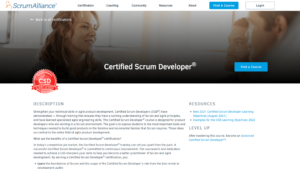
Scrum Events
The Scrum framework allots time for Scrum events (meetings) that can help create regularity. The events help teams organize work, plan sprints, discuss iterations and issues, review deliverables, and reflect on completed work. Below, we’ll take a look at the most common Scrum events.
Sprint Planning
During sprint planning, teams work to define the project scope (goal) for the next sprint. Scrum teams pick which user stories (features) from the product backlog to work on. After the meeting, everyone should be on the same page regarding what will be delivered by the end of the sprint. Products like ClickUp (here’s our ClickUp review) offer helpful sprint planning templates.

offered by project management platforms like ClickUp.
Sprints
A sprint is a period (usually two weeks, but as long as four) where development teams get their heads down and complete work on the current product increment. During this time, the sprint’s scope can be reevaluated, and work can be added if needed.
Backlog Organizing
The product owner constantly manages the product backlog. The idea is for the product owner to maintain, clean and prioritize backlog tasks through feedback from the development team. An organized task list is always ready to be pulled from at any time.
Daily Scrums
A daily scrum (stand-up) is a short meeting (usually 15 minutes) where team members discuss what they worked on the day before, what they will work on next and if they have any issues. The goal is to get the team on the same page and to ensure a plan is in place for the day.
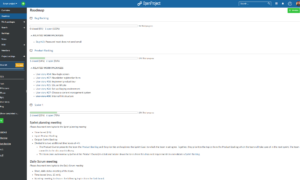
Sprint Retrospective
A sprint retrospective is a meeting that’s held at the end of every sprint. During sprint retros, team members discuss failures and wins that occurred during the sprint and how processes can be improved. If you’d like to learn more about this critical Scrum meeting, check out our guide to sprint retrospectives.

offer templates for sprint retrospective meetings.
Sprint Review
Sprint reviews, which are time-boxed to a maximum of four hours for a four-week sprint, give teams and stakeholders time to view software demos and software increments at the end of sprints. The reviews allow everyone to look over the backlog and receive customer feedback. During the review, the product owner decides whether to release the increment or hold it back for revisions.
Scrum Artifacts
Scrum artifacts sound complicated, but don’t worry. They’re just tools and pieces of information that Scrum teams use. Per scrum.org, there are three official Scrum artifacts: sprint backlogs, product backlogs and increments. Let’s take a closer look at them.
Sprint Backlog
A sprint backlog is made up of the sprint goal, an actionable plan, tasks, fixes and enhancements. The development team, in conjunction with the product owner, selects the tasks to work on during the sprint planning meeting for the current sprint cycle.
Product Backlogs
A product backlog is the master list (to-do list) of tasks and fixes the development team must complete to finish the project. The product backlog, which is ever-changing thanks to customer requests, is visited frequently by the development team and is maintained by the product owner.
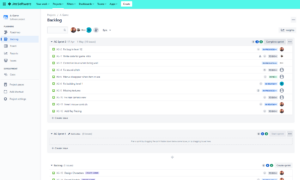
Increment
An increment is a working product that development teams deliver at the end of a sprint. In software development, the increment would be a tested iteration of software with all previously completed work, along with the newest features and customer requests from the current sprint.
Scrum vs Agile vs Kanban
There’s a lot of confusion regarding Agile ways of working. Somewhere along the way, the notion that Agile is a methodology crept in. Agile isn’t a methodology at all. Scrum and Kanban are also often confused as they use similar methods.
Below, we will look at Scrum vs Kanban and Scrum vs Agile so that you can better understand the differences between them.
Scrum vs Agile
As discussed in our Scrum vs Agile guide, Scrum is a project management methodology, whereas Agile is a set of principles and values. Agile methods embrace communication and collaboration and put the customer’s immediate needs above documentation and plans. Scrum’s developers embraced Agile principles and values and built a flexible framework around them.
Scrum vs Kanban
Scrum and Kanban are similar in that they use Agile boards (Kanban and Scrum boards) to visually represent the tasks of a project. However, Scrum is better for smaller teams and has more structure (artifacts, events and roles), making it suitable for complex projects. Kanban is for much larger Agile teams working on simpler projects with repeatable actions.
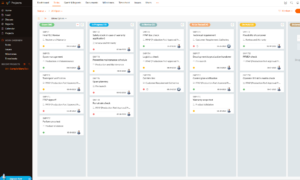
Benefits of Scrum Methodology
There are many benefits to Scrum. Start using it, and before long, you’ll see that it can help deliver quality products in a timely manner. It can help improve teamwork, increase flexibility and raise customer satisfaction. Scrum can also provide better returns on investment (ROI), as costly mistakes will happen less frequently.
Of course, there are downsides as well. Scrum can require extensive training, scope creep is a real problem and failure rates can be high if you don’t have committed team members. You need to weigh the pros and cons of Scrum before you decide to use it.
Getting Started With Scrum
Shifting from traditional methods to Agile ones might be daunting, but there’s no need to be afraid of Scrum. There are ways to prepare for the switch. Learning about the history of Scrum, the Scrum of Scrums (connecting multiple teams), and Scrum anti-patterns (bad behaviors) will help. You can also develop an understanding of Scrum principles, values, events and roles.
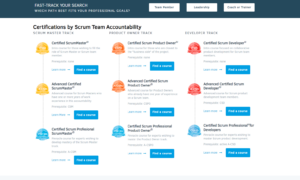
becoming certified in an area that interests you.
If you’re serious, you can look into Scrum training courses and learn about software that will help you and your team get through the Scrum process. Below, we’ll briefly cover Scrum certifications and some of the best project management software you can use.
Best Scrum Certifications & Courses
If Scrum sounds like something you want to be a part of, or if you’re already involved in Scrum teams and wish to progress your career, you’ll be pleased to know that there are numerous training and certification courses. For the sake of space, we won’t go into great detail about the certifications, but we will list the most popular Scrum-centric training options.
- Certified Scrum Master (CSM)
- Certified Scrum Product Owner (CSPO)
- Certified Scrum Developer (CSD)
- Certified Scrum Trainer (CST)
Best Project Management Software for Scrum
Some project management platforms are better than others regarding Scrum and sprint management. Below, we will quickly cover a few platforms that are featured in our roundup of the best Scrum software.
1. Jira

Pros:
- Intuitive Scrum tools
- Robust free plan
- Friendly pricing (mostly)
Cons:
- Lots of technical jargon
- Lacks versatility
- No small team discounts
Jira is easy to use and features robust scrum boards. There are dedicated backlog and issue-tracking tools, advanced reports that include burndown charts and collaborative documents. Jira can also integrate with Confluence, which provides access to sprint planners and retrospective templates.
If you’re worried about integrations and automations, don’t be; Jira supports both. You’ll also find built-in time-tracking tools. If you’d like to know more about Jira and its features, check out our Jira review. If you’d like to learn more about its pricing and plans, head over to our Jira pricing guide.
- Max. 10 users. unlimited boards, reports and insights; backlog; basic roadmaps; 2GB of storage; community support
- Annual price is for 10 users; with more than 10, annual pricing changes based on the number of users. Monthly pricing changes with teams over 100.
- Annual price is for 10 users; with more than 10, annual pricing changes based on the number of users. Monthly pricing changes with teams over 100.
2. Trello

Pros:
- Excellent free plan
- Incredibly easy to use
- Unlimited integrations
Cons:
- Bare bones mobile apps
- Not very versatile
- Not for complex projects
Trello is a relative of Jira and is one of the best kanban tools available. While it’s not as focused on Scrum as Jira, Trello can still be used by Scrum teams. The kanban boards in Trello are the best in the business. They’re endlessly customizable and very intuitive. Trello also offers countless templates that make getting started simple.
The biggest draws of Trello include its comprehensive free plan, unlimited integrations, mobile applications and built-in automations. To learn more about Trello’s features, check out our Trello review, and to see what plans are available, read our Trello pricing guide.
- Unlimited users, 10 boards, Unlimited power-ups, Unlimited storage
- Price is per user, Several new views
- Price is per user, Unlimited boards, Custom fields, Invite guests
3. Wrike

Pros:
- Tons of versatile tools
- Robust security features
- Easy to use
Cons:
- Odd pricing
- Bland user interface
- Privacy policy could be better
Wrike is an all-in-one project management suite that supports many ways of working, including Scrum. It is intuitive, and it has easy-to-use kanban boards, communication tools and advanced reports. It also has built-in time tracking and resource management features, supports integrations, and offers templates for sprint planning and retrospectives.
Wrike offers numerous plans, and there are optional add-ons that can enhance the software. You can learn more in our Wrike review, and you can see what plans are available and how much they cost in our Wrike pricing guide.
- Unlimited users. Basic features.
- Price is per user. No monthly option. Plans for 5 to 200 users.
- Price is per user. Plans for 5, 10 and 15 users.
Final Thoughts: Scrum
Thanks to its flexible, iterative and incremental approach, Scrum is loved by Agile teams. Whether you lead a team of software developers or manage engineers, product designers, small manufacturing teams or small groups in other industries, Scrum’s adaptive methods can be tailored to suit you.
If you value communication and collaboration over set-in-stone documents and plans and want to be part of a team that respects each other, Scrum could be for you.
Have you made the transition to Scrum? What project management method did you leave behind? What are your Scrum success stories? Let us know in the comments, and as always, thanks for reading.
FAQ: Scrum Explained
-
Scrum is a flexible project management methodology that breaks down tasks into small groups of work called “sprints.” Scrum champions face-to-face communication over documents and uses cross-functional teams that collaborate until project completion.
-
Scrum is an Agile project management methodology often used by software development teams. However, thanks to its flexible nature, Scrum can be used in a variety of industries.
-
Scrum is an Agile methodology that uses an iterative approach to working. The Scrum framework, which is based upon the values and principles found in the Agile Manifesto, helps teams deliver projects on time thanks to its collaborative nature.
-
Agile and Scrum are different. Agile is a set of principles and values that promote communication, flexibility and collaboration. Scrum is a way of working that incorporates Agile frameworks.
The post What Is Scrum? What You Need to Know in 2023 appeared first on Cloudwards.

